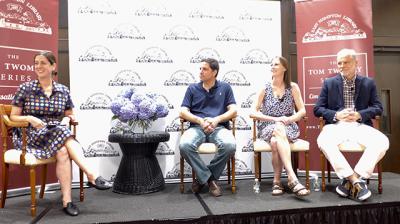Passion and Artistry in the East End’s Vineyards

“He was a bold man that first ate an oyster,” wrote Jonathan Swift, just as it was a brave couple that first tried to turn a Long Island potato field into a vineyard. Alex and Louisa Hargrave, neither of whom had ever grown grapes or made wine, bought a farm in Cutchogue in 1973, and in so doing they launched what has become the Long Island Viticultural Area, now home to some 60 wineries and vineyards.
Last Thursday, the East Hampton Library’s Tom Twomey Lecture Series, now in its third year, brought together three of the Island’s leading winemakers, who were asked by Amy Zavatto, director of the Long Island Merlot Alliance, to talk about the region, its wines, and what brought them to the East End from as far away as Germany’s Black Forest and the Napa Valley.
There was a consensus among Kelly Urbanik Koch, head winemaker at Macari Vineyards in Cutchogue, Kareem Massoud, winemaker and partner at Paumanok Vineyards in Aquebogue, and Roman Roth, winemaker and partner at Wolffer Estate Vineyard in Sagaponack, about what defines Long Island wines.
“I think the quick answer is that they’re moderate, well-balanced wines, and they’re delicious,” said Mr. Massoud.
“Well-balanced and refreshing,” said Ms. Koch. “The moderate alcohol is a big thing.”
“The best wines in the world have elegance, balance, and intensity,” said Mr. Roth. “Nobody in America can make more food-friendly wines than Long Island.”
Mr. Massoud said it was “easier for the wine to become more out of balance the higher you go in alcohol. Balance is having fluidity and harmony in the wine and not having any one component stand out more than any other.”
“Small wine regions and cooler climates have finally made enough noise,” said Mr. Roth, charting a typical wine drinker’s progress from Liebfraumilch and Mateus to the “big guns” of California, Australia, and Argentina, to the eventual realization that less can be more.
While the entire East End shares a cool maritime climate, there are minor differences between the North and South Forks, and even on the North Fork alone, where the west is somewhat warmer than the east. “Over in Riverhead we say we’re in the banana belt of the East End,” said Mr. Massoud. The relatively warmer climate allows for fuller ripening of red varietals, he said.
Ms. Koch agreed about the climatic differences, but said that “in the end, those things balance out, because we’re all surrounded by the water and its effect of moderation on our climate.”
A recurring subject was terroir, which refers to the complete natural environment in which a wine is produced, including the soil, topography, and climate. Both the North and South Forks share sandy, gravelly, well-draining subsoils, which are essential to winemaking here, since, unlike many of the world’s best sites, Long Island’s topography is flat.
The three winemakers arrived on the East End by very different paths. Mr. Roth, whose father was a winemaker and wine merchant, began his wine-making apprenticeship in Germany at the age of 16. He worked in California and Australia before returning to Germany. In 1992, Christian Wolffer invited him to Sagaponack.
“One reason I agreed to come was that he said Manhattan was a half-hour away from the Hamptons. It was a little stretch of the truth, but it worked.” Like Macari and Paumanok, Wolffer has always been a family-owned estate. “It’s the passion of the winemaking that counts, not the profit margin.”
Ms. Koch grew up in St. Helena, Calif., in the heart of the Napa Valley, and received a degree in viticulture and enology from the University of California at Davis.
“After working in Napa, I was curious to see what the rest of the world looked like. I came to Long Island looking to stay for a couple of years, but I never went back. I love Long Island, I’m really proud of the region, and I stand behind the wines here. We’re still kind of defining or creating the history of a new region, and that’s pretty cool.”
All the winemakers emphasized the risks inherent in their field. Mr. Massoud’s parents, who founded Paumanok Vineyards in 1983, “took the biggest gamble of all,” he said, “which was buying a potato farm on the East End and planting grapes. They weren’t the first to do that, but today Paumanok is one of a handful of the first estate wineries that are still owned and operated by the founders.”
Ms. Zavatto remarked that some people consider Long Island wines too expensive. Mr. Massoud pointed out that the Island’s geographic distance from any wine center means that a premium has to be paid for every piece of equipment shipped here. “Then there’s the cost of real estate, of property taxes, of electricity, of labor. These are about as high as anywhere in the world.” Ms. Koch noted that there was also a lot of hand-harvesting and care that go into the making of Long Island wines.
“We are a small wine region,” said Mr. Roth. “If a California winery does it, it’s terrific. We have to work twice as hard to prove ourselves.”
When asked about vintages, 2013 and 2014 were cited as ideal, with high yields and high quality. Mr. Roth said his 1995 pinot noir was probably the reason he is still here. “It got us into four-star restaurants in New York — Jean-Georges, Lespinasse, and Chanterelle — and Christian changed the name from Sag Pond Vineyards to Wolffer Estate because of it. Every vintage is special, though, since you give your heart and soul to each one.”
